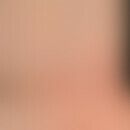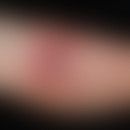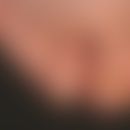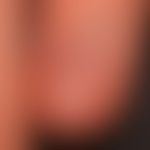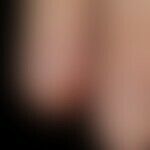Synonym(s)
DefinitionThis section has been translated automatically.
Frequent, acute, mostly bacterial, after banal trauma induced nail fold inflammation with reddened, swollen, painful nail fold (paronychium, see nail below).
PathogenThis section has been translated automatically.
Staphylococcus aureus, streptococci, Pseudomonas aeruginosa, Proteus mirabilis, yeasts (Candida albicans). Rare herpes simplex viruses.
You might also be interested in
EtiopathogenesisThis section has been translated automatically.
- Acute paronychia is mostly infectious caused by pyogenic cocci (rarely as syphilitic paronychia).
- If the course of the disease is recurrent, an infection by the herpes simplex virus must also be considered.
ManifestationThis section has been translated automatically.
Children and young people, also adults.
Herpes simplex virus-induced loco recurrent paronychia occurs predominantly in adults and is often combined with genital herpes simplex infection.
ClinicThis section has been translated automatically.
Inflammatory reddened, swollen, painful nail fold with emptying of pus droplets under pressure. Painful onycholysis is not uncommon.
TherapyThis section has been translated automatically.
For purulent paronychia: soap baths, lukewarm 5-10 min, best with curd soap, but also liquid soaps (bath water should appear milky turbid). Otherwise, lukewarm baths with disinfectant additives such as quinolinol (e.g., Chinosol 1:1000 or R042 ) or potassium permanganate (light pink). Antisepsis with polyvidone-iodine ointment dressings (e.g., R204, Braunovidone-iodine ointment) or dressings with sodium bituminosulfonate (e.g., Ichtholan special ointment, Ichthoseptal cream). Immobilization of the finger by means of a Böhler splint. In case of therapy resistance, nail extraction in LA is recommended. The infection heals promptly under this.
In case of extensive findings and/or progression of the inflammation under external therapy, antibiotic system therapy according to antibiogram. Initial application of cephalosporins such as cefuroxime (e.g. Elobact) 2 times/day 500 mg p.o. or gyrase inhibitors such as ofloxacin (e.g. Tavanic 200 mg/day p.o.).
Subsequent skin care: Desiccated nail folds should be regularly maintained with an O/W emulsion (e.g. Unguentum emulsificans aquosum preparation saturated with vegetable oils).
General therapyThis section has been translated automatically.
Note(s)This section has been translated automatically.
The superficial vesicular form of acute paronychia is a special form of bullous impetigo which is characterized by the topography. It is also known as bulla repens (or bulla roden or circulation). Deeper abscessed paronychia are generally called panaritium.
General information on prophylaxis:
- Regular prophylactic hand disinfection (e.g. with disinfectant spirit (NRF 11.27.)
- No cutting of the cuticle.
- Keep nails short.
- Do not cut toenails round.
- In case of nail wall injuries, consistent antiseptic local therapy, e.g. with Polyvidon Iodine Ointment R204.
Remember! In case of chronic paronychia think of Unguis incarnatus!
LiteratureThis section has been translated automatically.
- Chanprapaph K et al (2014) Epidermal growth factor receptor inhibitors: a review of cutaneous adverse events and management. Dermatol Res Pract doi: 10.1155/2014/734249
- Di Costanzo L et al (2014) Acrodermatitis continua of Hallopeau (ACH): two cases successfully treated with adalimumab. J Dermatologist Treat 25:489-494
- Iorizzo M (2015) Tips to treat the 5 most common nail disorders: brittle nails, onycholysis, paronychia, psoriasis, onychomycosis. Dermatol Clin 33:175-183
- Shafritz AB et al (2014) Acute and chronic paronychia of the hand. J Am AcadOrthop Surg 22: 165-174
Incoming links (23)
Acrodermatitis enteropathica; Bulla repens; Cetuximab; Circulation; Envy nail; Erlotinib; Finger circulation; Flucloxacillin; Gefitinib; Lambliasis; ... Show allOutgoing links (21)
Acrocyanosis; Atopic dermatitis (overview); Bulla repens; Cefuroxime; Cephalosporins; Disinfectant spirit (nrf 11.27.); Gyrase inhibitors; Gyrase-Hemmer; Fluorchinolone; ; Herpes simplex virus infections; Hyperhidrosis (overview); Local anesthesia; ... Show allDisclaimer
Please ask your physician for a reliable diagnosis. This website is only meant as a reference.
